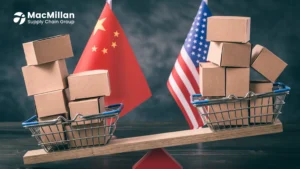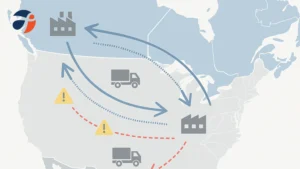Landed cost is a crucial and often rigid component of eCommerce pricing. It encompasses all expenses, shipping, taxes, and import fees, that directly affect a company’s profitability. For example, a $5 pair of shoes can end up costing $70 in-store due to these cumulative costs.
Now more than ever, e-commerce businesses are prioritizing reduced logistics costs to maximize revenue. For brands shipping from Canada, any opportunity to influence landed cost is significant. Enter Section 321. Although not a new regulation from U.S. Customs and Border Protection, the recent increase in the exemption limit from $200 USD to $800 USD per person per day has dramatically shifted the landscape for MacMillan’s Fulfillment clients and other Canadian eCommerce and logistics companies. This change presents a valuable opportunity to optimize fulfillment strategies and improve cost efficiency.
In this article we dive into what is section 321? how you can use it for your advantage and how MacMillan SCG can help create value?
What is section 321? – Explained
Here’s a brief overview: This Section permits individual consumers to purchase and ship up to $800 USD worth of goods per day from Canada to the United States without incurring any duty fees or taxes.
For eCommerce brands, this means that their products can be shipped duty-free to U.S. customers, provided that each individual order does not exceed the $800 USD daily limit.
For these reasons, section 321 can give e-commerce businesses a competitive edge and reclaim revenue previously spent on taxes.
This provision is applicable when importing goods from Canada into the U.S. Following MacMillan’s acquisition of Canadian warehouses in 2021, MacMillan now offers the benefits of the section for shipments originating from Canada. Moreover, how to use section to import and its long term benefits for your business.
How does section 321 work?
Section 321 has enabled MacMillan to capitalize on our expanded Canadian operations, introducing new strategies like zone skipping to expedite product delivery across the border.
One common concern among brands is the potential for shipping delays and compromised customer service when importing goods to Canada. However, the process remains remarkably efficient, with minimal delay time between receiving goods in Canada and the U.S.
Here’s how it works:
- Goods are imported into Canada.
- They can then be transported to our Canadian warehouses in Brampton and GTA area while covering 80% of the western region providing real-time visibility to the customers.
- Once received, the goods are checked into inventory and made available for order.
- When a customer places an order, MacMillan picks, packs, and labels the package with a domestic shipping label on the same day while providing tracking facilities.
- The package is then shipped across the border into the U.S. on that same day delivery schedules.
- Upon entering the U.S., the package is handed over to the chosen domestic carrier (e.g., UPS, USPS, FedEx).
- The package continues its journey through the U.S. to the customer’s doorstep.
With this streamlined process, there’s virtually no delay, regardless of whether your products enter the U.S. or Canada first. By shipping goods a bit further, you can take advantage of duty-free benefits without sacrificing delivery speed.
How e-Commerce Brands Can Maximize Savings?
While the section itself doesn’t directly reduce costs, the real financial advantage comes from importing goods into Canada. Thanks to Canada’s favorable Free Trade Agreements, brands can benefit from duty deferral or duty drawback programs, which either waive or reimburse the duties on imported goods.
Let’s break down the potential savings with an example:
Import to Canada
• Item: One pair of shoes imported from China to Canada
• Value for Duty: $12.00
• Duty Rate: 18% ($2.16)
• Savings: $2.16 (for just one pair of shoes) through Duty Drawback or Duty Deferral
Consider the savings when scaling up to 100 or 500 pairs of shoes. While the duty rate for shoes is 18%, rates for other products can range from 20-25%. Such savings are significant and can substantially enhance your brand’s profitability.
How Section 321 Can Benefit Your e-Commerce Store?
After identification of what is section 321 and how it works, Section 321 can significantly lower your international fulfillment costs by enabling duty-free and tax-free imports into the U.S. Here’s how it helps:
- Reduced Costs: It allows for the duty-free import of low-value goods, potentially exempting shipments from Section 301 tariffs if manufactured overseas.
- Faster Shipments: By minimizing paperwork and using the e-Manifest electronic filing system, Section 321 speeds up customs processing and reduces delays, ensuring quicker delivery to customers.
- Competitive Advantage: Lower international shipping costs and the ability to bulk ship to U.S. fulfillment centers can enhance your affordability and shipping rates, leading to faster domestic delivery and improved customer satisfaction.
How MacMillan Facilitates Section 321?
Here’s the advantage for eCommerce brands of all sizes looking to leverage the Section model: MacMillan handles the complexities for you. Our team collaborates with clients to identify the most effective duty elimination or drawback program, simplifying the setup process.
We also manage the logistics of moving products from Canadian ports to our 3PL warehouse in Brampton and the Greater Toronto Area.
Brands benefit from our exceptional client service and see a direct impact on their revenue through easier, duty-free importing and shipping.
As global shipping continues to evolve, adopting Section 321 with MacMillan Canada is a strategic move in navigating the future of cost-effective and efficient international logistics.
Section-321 FAQ’s
How Section 321 Impacts Shipments to and from China?
The US-China trade war has led to substantial increases in tariffs between the two countries. However, Section 321 offers a strategic advantage by allowing businesses to import goods from China to the United States without incurring hefty taxes and duties. Essentially, shipments that qualify under Section 321 are exempt from the additional tariffs imposed by Section 301.
How Section 321 Reduces Import Costs for eCommerce?
Section 321 offers eCommerce businesses a valuable advantage by allowing the import of low-value products into the U.S. without incurring duties and taxes. This de minimis value threshold simplifies the import process with reduced paperwork. Beyond cutting international shipping costs, Section 321 also accelerates the cross-border shipping process, making it more efficient for businesses to get products to U.S. consumers quickly.
Understanding How Entry Type 86 differs from Section 321
Entry Type 86 is a customs entry framework used by U.S. Customs and Border Protection (CBP) to facilitate the clearance of low-value shipments into the U.S. Section 321, on the other hand, is a CBP program specifically designed to allow for the duty-free import of goods valued at $800 or less per person per day.
Key Take Aways
Section 321 represents a game-changing opportunity for eCommerce businesses looking to optimize their landed costs and enhance their fulfillment strategies. By enabling duty-free and tax-free imports of low-value goods into the U.S., Section 321 reduces overall shipping expenses and accelerates delivery times. This is particularly advantageous for brands shipping from Canada, as it allows them to leverage Canada’s favorable Free Trade Agreements and efficient logistics solutions.
MacMillan SCG’s expertise in navigating Section 321 ensures that businesses can fully capitalize on these benefits, streamlining their international operations and boosting profitability. As the global shipping landscape evolves, embracing Section 321 with MacMillan is a strategic move towards more cost-effective and efficient logistics.



